CIVIL ENGINEERING
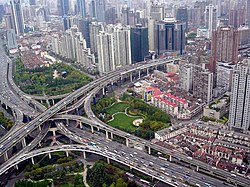 |
| A multi-level stack interchange , buildings , houses , and park in Shanghai , China |
Civil engineering is a professional engineering subject that deals with the design, creation, and preservation of the physical and clearly built environment, which include public works inclusive of roads, bridges, canals, dams, airports, sewage systems, pipelines, structural components of homes, and railways.
Civil engineering is historically broken into some of sub-disciplines. It is considered the second one-oldest engineering field after military engineering, and it is described to differentiate non-military engineering from military engineering. Civil engineering can take location within the public zone from municipal public works departments via to federal authorities companies, and inside the private quarter from domestically based totally companies to international Fortune 500 businesses.
History
Civil engineering as a discipline
Civil engineering is the utility of physical and scientific standards for solving the problems of society, and its history is intricately related to advances within the expertise of physics and mathematics throughout history. Because civil engineering is a extensive profession, together with numerous specialized sub-disciplines, its records is connected to knowledge of structures, substances science, geography, geology, soils, hydrology, environmental technological know-how, mechanics, project control, and other fields.
Throughout historical and medieval history maximum architectural layout and production changed into achieved through artisans, including stonemasons and carpenters, rising to the function of grasp builder. Knowledge was retained in guilds and seldom supplanted with the aid of advances. Structures, roads, and infrastructure that existed have been repetitive, and increases in scale were incremental.
One of the earliest examples of a systematic approach to physical and mathematical problems relevant to civil engineering is the paintings of Archimedes inside the third century BC, together with Archimedes Principle, which underpins our understanding of buoyancy, and practical solutions along with Archimedes' screw. Brahmagupta, an Indian mathematician, used mathematics within the 7th century AD, based on Hindu-Arabic numerals, for excavation (extent) computations.
Civil engineering profession
Engineering has been an element of life for the reason that beginnings of human lifestyles. The earliest exercise of civil engineering may additionally have started between 4000 and 2000 BC in historic Egypt, the Indus Valley Civilization, and Mesopotamia (historic Iraq) whilst humans commenced to desert a nomadic existence, developing a want for the development of refuge. During this time, transportation became increasingly more crucial leading to the development of the wheel and crusing.
 |
| Leonhard Euler developed the concept explaining the buckling of columns. |
Until contemporary instances there was no clear difference among civil engineering and structure, and the time period engineer and architect had been in particular geographical variations referring to the equal occupation, and frequently used interchangeably. The construction of pyramids in Egypt (circa 2700–2500 BC) have been a number of the primary instances of large structure buildings. Other historic ancient civil engineering structures consist of the Qanat water control system (the oldest is older than 3000 years and longer than 71 km,) the Parthenon by Iktinos in Ancient Greece (447–438 BC), the Appian Way by means of Roman engineers (c. 312 BC), the Great Wall of China by way of General Meng T'ien below orders from Ch'in Emperor Shih Huang Ti (c. 220 BC) and the stupas built in historic Sri Lanka just like the Jetavanaramaya and the full-size irrigation works in Anuradhapura. The Romans developed civil systems at some stage in their empire, including especially aqueducts, insulae, harbors, bridges, dams and roads.
 |
| A Roman aqueduct [built circa 19 BC], Pont du Gard, France |
In the 18th century, the time period civil engineering become coined to contain all things civilian in preference to military engineering. In 1747, the first organization for the coaching of civil engineering, the École Nationale des Ponts et Chaussées was established in France; and extra examples followed in other European nations, like Spain. The first self-proclaimed civil engineer changed into John Smeaton, who built the Eddystone Lighthouse. In 1771 Smeaton and a number of his colleagues fashioned the Smeatonian Society of Civil Engineers, a group of leaders of the career who met informally over dinner. Though there has been evidence of some technical conferences, it was little extra than a social society.
 |
John Smeaton , the ( father of civil engineering ) |
In 1818 the Institution of Civil Engineers changed into founded in London, and in 1820 the eminent engineer Thomas Telford have become its first president. The group received a Royal Charter in 1828, formally recognising civil engineering as a career. Its constitution defined civil engineering as:
The artwork of directing the super sources of power in nature for the use and convenience of guy, because the way of manufacturing and of site visitors in states, both for external and inner alternate, as applied inside the construction of roads, bridges, aqueducts, canals, river navigation and docks for inner intercourse and exchange, and in the construction of ports, harbours, moles, breakwaters and lighthouses, and inside the art of navigation by artificial energy for the purposes of trade, and in the production and application of equipment, and in the drainage of cities and cities.
Civil engineering education
The first private university to teach civil engineering in the United States became Norwich University, founded in 1819 by way of Captain Alden Partridge. The first diploma in civil engineering inside the United States become provided with the aid of Rensselaer Polytechnic Institute in 1835. The first such degree to be offered to a lady turned into granted by way of Cornell University to Nora Stanton Blatch in 1905.
In the United Kingdom at some stage in the early 19th century, the division among civil engineering and army engineering (served through the Royal Military Academy, Woolwich), coupled with the demands of the Industrial Revolution, spawned new engineering training tasks: the Class of Civil Engineering and Mining become based at King's College London in 1838, specifically as a reaction to the growth of the railway gadget and the need for more certified engineers, the personal College for Civil Engineers in Putney was installed in 1839, and the UK's first Chair of Engineering become set up at the University of Glasgow in 1840.
Education
Civil engineers commonly possess an academic diploma in civil engineering. The period of take a look at is three to five years, and the completed diploma is designated as a bachelor of era, or a bachelor of engineering. The curriculum usually consists of classes in physics, mathematics, mission control, layout and precise subjects in civil engineering. After taking fundamental publications in maximum sub-disciplines of civil engineering, they circulate on to concentrate on one or greater sub-disciplines at advanced tiers. While an undergraduate degree (BEng/BSc) normally gives a hit students with industry-permitted qualification, a few academic institutions provide put up-graduate ranges (MEng/MSc), which permit students to similarly specialize in their specific region of interest.
Practicing engineers
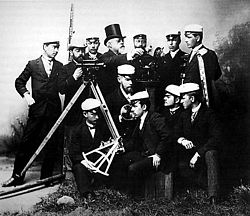 |
| Surveying students with professor on the Helsinki University of Technology in the past due nineteenth century. |
In most international locations, a bachelor's degree in engineering represents the first step closer to expert certification, and a professional body certifies the diploma software. After completing a licensed degree software, the engineer need to satisfy more than a few requirements together with work enjoy and examination necessities before being certified. Once licensed, the engineer is certain as a expert engineer (inside the United States, Canada and South Africa), a chartered engineer (in most Commonwealth nations), a chartered expert engineer (in Australia and New Zealand), or a European engineer (in maximum international locations of the European Union). There are global agreements among relevant expert our bodies to allow engineers to practice throughout national borders.
The advantages of certification range depending upon location. For instance, inside the United States and Canada, "simplest a certified expert engineer may also prepare, signal and seal, and submit engineering plans and drawings to a public authority for approval, or seal engineering work for public and personal clients." This requirement is enforced underneath provincial regulation along with the Engineers Act in Quebec. No such legislation has been enacted in other nations inclusive of the United Kingdom. In Australia, country licensing of engineers is restrained to the kingdom of Queensland. Almost all certifying bodies preserve a code of ethics which all members need to abide with the aid of.
Engineers ought to obey contract law of their contractual relationships with different parties. In instances where an engineer's paintings fails, they will be challenge to the law of tort of negligence, and in extreme cases, crook prices. An engineer's paintings ought to additionally comply with numerous other policies and rules inclusive of building codes and environmental regulation.
Sub-disciplines
 |
| The Akashi Kaikyō Bridge in Japan, currently the arena's longest suspension span. |
There are some of sub-disciplines within the vast discipline of civil engineering. General civil engineers paintings closely with surveyors and specialised civil engineers to layout grading, drainage, pavement, water supply, sewer service, dams, electric and communications supply. General civil engineering is also called web page engineering, a branch of civil engineering that mostly specializes in changing a tract of land from one usage to every other. Site engineers spend time traveling assignment sites, assembly with stakeholders, and making ready construction plans. Civil engineers follow the standards of geotechnical engineering, structural engineering, environmental engineering, transportation engineering and construction engineering to residential, business, commercial and public works tasks of all sizes and degrees of creation.
Coastal engineering
Coastal engineering is concerned with coping with coastal areas. In a few jurisdictions, the phrases sea defense and coastal protection suggest defense against flooding and erosion, respectively. The term coastal defense is the more conventional term, however coastal control has turn out to be more famous as the field has accelerated to techniques that permit erosion to say land.
Construction engineering
Construction engineering involves planning and execution, transportation of substances, web page development based on hydraulic, environmental, structural and geotechnical engineering. As construction firms generally tend to have higher business chance than other forms of civil engineering firms do, construction engineers regularly engage in extra commercial enterprise-like transactions, as an example, drafting and reviewing contracts, comparing logistical operations, and tracking fees of elements.
Earthquake engineering
Earthquake engineering involves designing systems to face up to dangerous earthquake exposures. Earthquake engineering is a sub-subject of structural engineering. The major goals of earthquake engineering are to understand interplay of systems on the shaky ground; foresee the outcomes of possible earthquakes; and layout, construct and preserve systems to carry out at earthquake in compliance with constructing codes.
Environmental engineering
 |
| Creek contaminated with water pollution |
Environmental engineering is the current time period for sanitary engineering, though sanitary engineering historically had not included a whole lot of the hazardous waste management and environmental remediation work covered by way of environmental engineering. Public health engineering and environmental fitness engineering are different phrases being used.
Environmental engineering deals with treatment of chemical, organic, or thermal wastes, purification of water and air, and remediation of infected websites after waste disposal or unintended infection. Among the subjects covered by environmental engineering are pollutant transport, water purification, waste water remedy, air pollutants, strong waste treatment, recycling, and unsafe waste control. Environmental engineers administer pollution discount, green engineering, and commercial ecology. Environmental engineers additionally assemble facts on environmental effects of proposed actions.
Forensic engineering
Forensic engineering is the research of materials, products, structures or additives that fail or do now not perform or function as meant, inflicting non-public harm or damage to property. The results of failure are dealt with by the regulation of product liability. The subject additionally offers with retracing approaches and tactics leading to injuries in operation of automobiles or equipment. The subject is applied maximum commonly in civil law instances, although it may be of use in crook regulation cases. Generally the cause of a Forensic engineering research is to locate reason or causes of failure as a way to enhance overall performance or existence of a aspect, or to assist a court docket in determining the statistics of an coincidence. It can also involve investigation of highbrow property claims, mainly patents.
Geotechnical engineering
 |
| A phase diagram of soil indicating the weights and volumes of air, soil, water, and voids. |
Geotechnical engineering studies rock and soil assisting civil engineering structures. Knowledge from the sector of soil technology, materials technology, mechanics, and hydraulics is implemented to soundly and economically design foundations, keeping partitions, and other structures. Environmental efforts to guard groundwater and correctly keep landfills have spawned a new place of studies called geo-environmental engineering.
Identification of soil properties offers challenges to geotechnical engineers. Boundary situations are often well defined in different branches of civil engineering, however unlike metallic or concrete, the fabric properties and behavior of soil are hard to expect because of its variability and quandary on research. Furthermore, soil exhibits nonlinear (stress-established) electricity, stiffness, and dilatancy (volume change associated with software of shear strain), making analyzing soil mechanics all of the extra tough. Geotechnical engineers regularly work with professional geologists and soil scientists.
Materials science and engineering
Materials technological know-how is carefully related to civil engineering. It research fundamental characteristics of substances, and offers with ceramics which includes concrete and blend asphalt concrete, sturdy metals which include aluminum and steel, and thermosetting polymers inclusive of polymethylmethacrylate (PMMA) and carbon fibers.
Materials engineering involves safety and prevention (paints and finishes). Alloying combines two kinds of metals to provide every other steel with desired houses. It contains factors of carried out physics and chemistry. With recent media attention on nanoscience and nanotechnology, substances engineering has been at the vanguard of academic research. It is also an crucial part of forensic engineering and failure evaluation.
Site development and plaining
 |
| Plan draft of proposed mixed-use site |
Site improvement, additionally called web page making plans, is focused at the planning and development capability of a website in addition to addressing viable impacts from allowing troubles and environmental challenges.
Structure engineering
 |
| Burj Khalifa animation of construction process |
Structural engineering is concerned with the structural design and structural analysis of buildings, bridges, towers, flyovers (overpasses), tunnels, off shore systems like oil and gasoline fields inside the sea, aerostructure and different systems. This includes identifying the hundreds which act upon a structure and the forces and stresses which stand up inside that shape because of those loads, and then designing the structure to correctly support and resist those hundreds. The hundreds may be self weight of the systems, other dead load, live hundreds, moving (wheel) load, wind load, earthquake load, load from temperature trade and so on. The structural engineer have to layout structures to be secure for their users and to efficaciously fulfill the function they're designed for (to be serviceable). Due to the character of some loading situations, sub-disciplines inside structural engineering have emerged, inclusive of wind engineering and earthquake engineering.
Design issues will include electricity, stiffness, and stability of the shape when subjected to masses which may be static, such as furniture or self-weight, or dynamic, along with wind, seismic, crowd or automobile loads, or transitory, including temporary production masses or impact. Other issues consist of value, constructability, safety, aesthetics and sustainability.
Surveying
 |
| A student using a dumpy level |
Surveying is the method via which a surveyor measures positive dimensions that occur on or near the floor of the Earth. Surveying system which include ranges and theodolites are used for accurate size of angular deviation, horizontal, vertical and slope distances. With computerisation, electronic distance size (EDM), total stations, GPS surveying and laser scanning should a massive volume supplanted traditional contraptions. Data accrued by survey dimension is converted into a graphical illustration of the Earth's surface inside the form of a map. This information is then used by civil engineers, contractors and realtors to layout from, construct on, and exchange, respectively. Elements of a structure should be sized and positioned with regards to every different and to web page obstacles and adjoining structures.
Although surveying is a awesome profession with separate qualifications and licensing arrangements, civil engineers are trained in the basics of surveying and mapping, as well as geographic records systems. Surveyors additionally lay out the routes of railways, tramway tracks, highways, roads, pipelines and streets in addition to role different infrastructure, including harbors, earlier than construction.
Land surveying
In the United States, Canada, the UK and maximum Commonwealth countries land surveying is considered to be a separate and wonderful profession. Land surveyors are not taken into consideration to be engineers, and feature their own expert associations and licensing requirements. The services of a licensed land surveyor are generally required for boundary surveys (to establish the bounds of a parcel the usage of its legal description) and subdivision plans (a plot or map based totally on a survey of a parcel of land, with boundary traces drawn inside the larger parcel to indicate the creation of latest boundary strains and roads), both of which can be generally referred to as Cadastral surveying.
Construction surveying
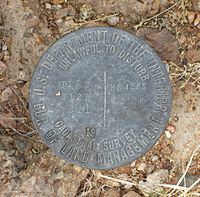 |
| BLM cadastral survey marker from 1992 in San Xavier, Arizona. |
Construction surveying is typically accomplished through specialised technicians. Unlike land surveyors, the ensuing plan does not have felony reputation. Construction surveyors perform the subsequent tasks:
* Surveying existing situations of the future work web page, consisting of topography, present buildings and infrastructure, and underground infrastructure whilst possible;
* "lay-out" or "setting-out": setting reference factors and markers so one can manual the development of new systems inclusive of roads or homes;
* Verifying the location of systems in the course of creation;
* As-Built surveying: a survey carried out at the quit of the development mission to confirm that the work legal was finished to the specifications set on plans.
Transportation engineering
Transportation engineering is concerned with transferring people and goods efficaciously, appropriately, and in a way conducive to a vibrant network. This includes specifying, designing, building, and retaining transportation infrastructure which includes streets, canals, highways, rail systems, airports, ports, and mass transit. It consists of regions inclusive of transportation design, transportation making plans, visitors engineering, some elements of city engineering, queueing principle, pavement engineering, Intelligent Transportation System (ITS), and infrastructure management.
Municipal or urban engineering
 |
| The engineering of this roundabout in Bristol, England, tries to make site visitors drift loose-moving |
Municipal engineering is concerned with municipal infrastructure. This entails specifying, designing, building, and maintaining streets, sidewalks, water deliver networks, sewers, avenue lighting fixtures, municipal solid waste control and disposal, storage depots for diverse bulk substances used for preservation and public works (salt, sand, etc.), public parks and cycling infrastructure. In the case of underground application networks, it is able to additionally encompass the civil portion (conduits and get entry to chambers) of the nearby distribution networks of electrical and telecommunications offerings. It also can consist of the optimizing of waste collection and bus provider networks. Some of these disciplines overlap with other civil engineering specialties, but municipal engineering specializes in the coordination of these infrastructure networks and offerings, as they may be frequently built concurrently, and managed through the identical municipal authority. Municipal engineers may additionally design the website civil works for large homes, business flora or campuses (i.E. Access roads, parking lots, potable water deliver, treatment or pretreatment of waste water, site drainage, and so on.)
Water resources engineering
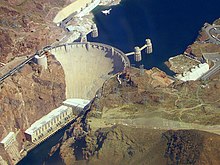 |
| Hoover Dam |
Water assets engineering is concerned with the gathering and management of water (as a natural useful resource). As a discipline it consequently combines factors of hydrology, environmental technological know-how, meteorology, conservation, and aid control. This vicinity of civil engineering relates to the prediction and management of each the fine and the quantity of water in both underground (aquifers) and above floor (lakes, rivers, and streams) resources. Water useful resource engineers examine and version very small to very large areas of the earth to are expecting the quantity and content material of water as it flows into, through, or out of a facility. Although the real design of the facility can be left to different engineers.
Hydraulic engineering is involved with the float and conveyance of fluids, principally water. This place of civil engineering is in detail associated with the layout of pipelines, water supply community, drainage facilities (inclusive of bridges, dams, channels, culverts, levees, hurricane sewers), and canals. Hydraulic engineers design these centers using the ideas of fluid stress, fluid statics, fluid dynamics, and hydraulics, among others.
Civil engineering systems
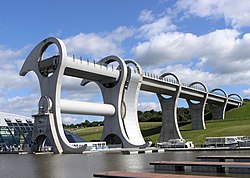 |
| The Falkirk Wheel in scotland |
Civil engineering structures is a field that promotes the use of structures thinking to manage complexity and trade in civil engineering inside its wider public context. It posits that the right development of civil engineering infrastructure requires a holistic, coherent know-how of the relationships among all of the vital factors that make a contribution to a hit projects even as at the identical time emphasizing the importance of attention to technical element. Its purpose is to assist integrate the entire civil engineering venture existence cycle from conception, thru making plans, designing, making, running to decommissioning.
WRITTEN BY : ADRISH WAHEED
Labels: CIVIL ENGINEERING

0 Comments:
Post a Comment
Subscribe to Post Comments [Atom]
<< Home